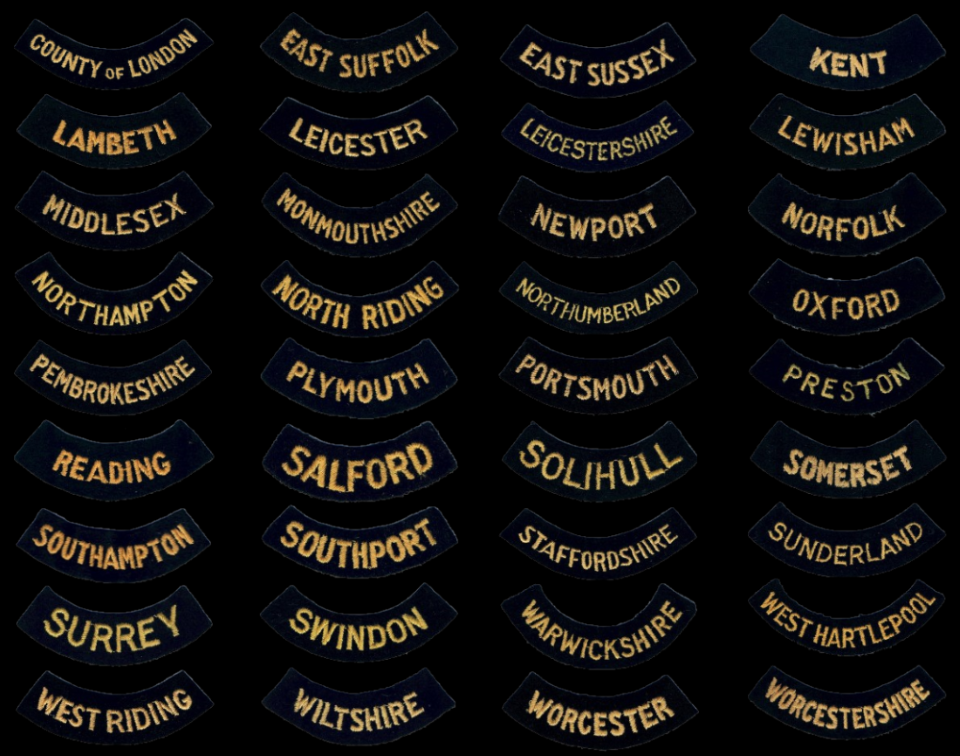
Civil Defence Corps Badges
The badges described here are those used by the UK Civil Defence Corps during the Cold War. One frequently sees badges miss-described on auction sites, this page is an attempt to be definitive. Badges which show "Civil Defence Corps" cannot be WWII, as the Corps was not formed until 1949! You will also find printed cloth badges these will be fakes or WWII as all cloth badges from the Cold War period were embroidered. There are also a number of other badges that were issued during the early life of the Corps, for sections that either only existed for a short time, or that were re-named. I don't have any of these.
Corps badge
The Civil Defence Corps Corps badge was worn on the beret and the left breast pocket of the battledress blouse. The beret was worn so that the badge was centred over the left eye.
County badges
Beneath the breast pocket Corps badge was worn the county or divisional badge, a selection of which is shown below. According to uniform instructions the badge was to be sewn so that it touched the bottom edge of the breast pocket badge.
Corps section badges
Section badges were worn one finger width below the seam on both shoulders, with sub-section badges, where appropriate immediately below.
Instructor badges
Instructors were trained either locally, or at Civil Defence training schools. In the case of locally trained instructor's the badge was blue, and for those trained at the Home Office schools it was in silver thread, for advanced trained instructors gold. The badge was worn on both sleeves of the battledress blouse, midway between the cuff and elbow, unless first aid badges were worn, in which case they were worn with the badges equidistant, half an inch apart, with the instructor badge lower.
First Aid badges
Members of the Ambulance and First Aid section were trained by one of the major first aid organisations, St John Ambulance, British Red Cross or the St Andrews Ambulance. Training was to the advanced standard with both a practical and a theoretical examination, the latter being conducted by a doctor. Badges were worn as described above. Members of other sections also had the option to take first aid courses and wear the appropriate badge.
Proficiency badges
Upon completion of intermediate training volunteers became eligible for an annual bounty payment, dependent on rank, this was £10, £12 or £15 a year during the last few years of the Corps. A further period, of perhaps 12-24 months would be required to achieve the advanced test. For promotion beyond basic grade, it was necessary to complete at least 50 hours training per year, and to pass the intermediate level test. The badges consisted of a five pointed star, the basic being silver, the intermediate being silver with a red surround, and the advanced, gold. Badges were worn two inches above the cuff on either sleeve.
Badges of Rank
| HEADQUARTERS SECTION |
WARDEN SECTION |
RESCUE SECTION |
WELFARE SECTION |
AMBULANCE & FIRST AID
SECTION |
|||
| Intelligence
& Operations sub-Section |
Signal
sub-Section |
Scientific
& Reconnaissance sub-Section |
|||||
 |
Chief Officer |
Chief Officer |
Chief Officer |
Chief Warden |
Chief Rescue Officer |
Chief Welfare Section Officer |
Chief Ambulance Officer |

|
Senior
Staff Officer |
Senior Signal Officer |
Senior Scientific
Intelligence Officer |
Deputy Chief Warden |
Deputy Chief Rescue Officer |
Deputy Chief Welfare Section
Officer |
Deputy Chief Ambulance
Officer |
 |
Column Rescue Officer |
Column Ambulance Officer |
|||||
 |
Assistant Chief Warden |
Deputy Column Rescue Officer |
Deputy Column Ambulance
Officer |
||||
 |
Staff
Officer (Operations) Staff Officer (Intelligence) Senior Staff Officer |
Signal
Officer |
Scientific
Intelligence Officer Reconnaissance Officer |
Sector
Warden |
Company Rescue Officer |
Assistant Chief Welfare
Officer |
Company Ambulance Officer Company First Aid Officer |

|
Deputy Sector Warden |
Deputy Company Rescue Officer |
Senior Welfare Section
Officer |
Deputy Company Ambulance
Officer Deputy Company First Aid Officer |
|||
 |
Post Warden |
Platoon Rescue Officer |
Platoon Ambulance Officer Platoon First Aid Officer |
||||

|
Signalmaster |
Deputy Post warden |
Deputy Platoon Rescue Officer |
Welfare Section Officer |
Deputy Platoon Ambulance
Officer Deputy Platoon First Aid Officer |
||
 |
Operations Clerk Intelligence Clerk |
Signal Clerk Field Cable Party Leader |
Reconnaissance Party Leader |
Senior Warden |
Rescue Party Leader |
Welfare Section Detachment
Leader |
Ambulance Detachment Leader First Aid Party Leader |
 |
|
Deputy Rescue Party Leader |
Deputy Ambulance Detachment
Leader Deputy First Aid Party Leader |
||||
 |
Not used during
the Cold War |
||||||
Chevrons were worn on the upper left arm, midway between the elbow and the shoulder seam, other badges were worn on both shoulders.
Lapel badges
Brassards or Arm Bands
With the exception of videos the site
content of Tocsin-Bang
by Stephen J. Cook is
licensed under CC
BY-NC-ND 4.0







